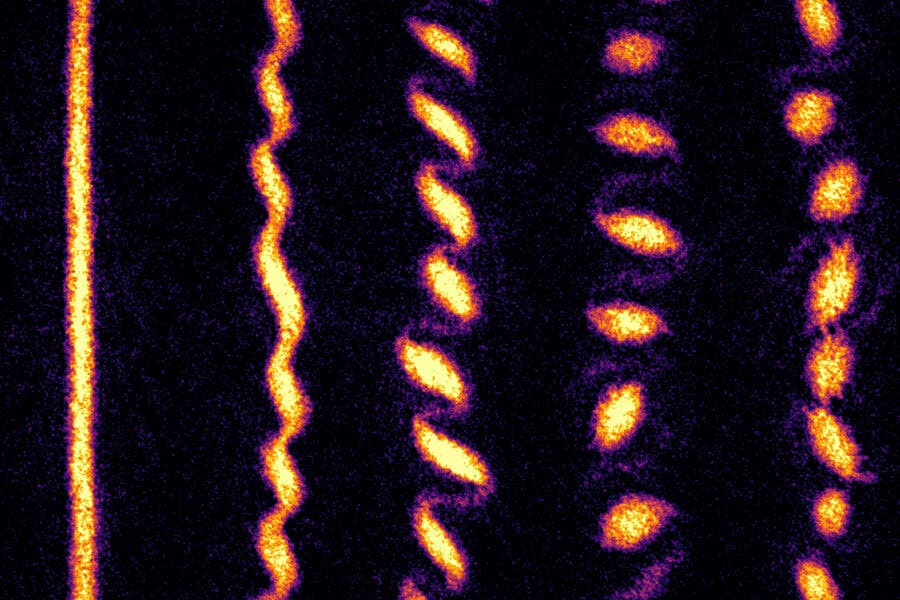
The familiar universe around us behaves in largely predictable ways, physically speaking. It’s why we’re confident to board a flight or we don’t act surprised when a computer performs a task exactly as instructed. But when zooming into the world of the very small, at the atomic level, our assumptions about how the universe works — a model known as classical physics — start to break down. Case in point, MIT physicists have coaxed a bunch of ultra-chilled atoms to exhibit a never before seen phenomenon: a crystal made of ‘quantum tornadoes’.
Welcome to the bizarre world of quantum physics. Get in, no time to explain!
Before delving into the specifics of this latest research, it’s worth taking a trip down memory lane, back to the 1980s. This was a fruitful decade in physics, with a lot of particle physics activity that eventually led to the discovery of a new family of matter known as quantum Hall fluids and consisting of clouds of electrons suspended in magnetic fields.
Classical physics dictates that the electrons in the Hall ‘fluid’ should repel each other and arrange themselves in an orderly lattice, forming a crystal. Except that no. Just no. Instead, the particles always adjusted their behavior to what their neighbors were doing, all in a correlated way.
“People discovered all kinds of amazing properties, and the reason was, in a magnetic field, electrons are (classically) frozen in place—all their kinetic energy is switched off, and what’s left is purely interactions,” says Richard Fletcher, assistant professor of physics at MIT. “So, this whole world emerged. But it was extremely hard to observe and understand.”
Fletcher and Martin Zwierlein, the Thomas A. Frank Professor of Physics at MIT, wondered if they could replicate this effect in an experiment that makes it easier to see. Electrons in a magnetic field move in very small increments, and the researchers thought that since the motion of atoms under rotation can occur over much larger length scales, they could afford to use ultracold atoms in lieu of electrons to make a nice light show.
For their study, they used lasers to trap around one million sodium atoms, cooling them to around 100 nanokelvins, a hair’s breadth away from absolute zero. A system of electromagnets both further confined the atoms and collectively spun them around like marbles in a bowl at about 100 rotations per second.
Using high-speed precision optical cameras to observe what was happening at the molecular level, the physicists found that the atoms spun into a long thread at around the 100-millisecond mark. This was the threshold at which the atoms’ behavior crossed the quantum barrier.
“In a classical fluid, like cigarette smoke, it would just keep getting thinner,” Zwierlein says. “But in the quantum world, a fluid reaches a limit to how thin it can get.”
“When we saw it had reached this limit, we had good reason to think we were knocking on the door of interesting, quantum physics,” adds Fletcher. “Then the question was, what would this needle-thin fluid do under the influence of purely rotation and interactions?”
As atoms continued to spin, quantum instability kicked in. The thread wavered, then turned the shape of a corkscrew, before finally breaking into a string of rotating blobs resembling tornadoes. The authors called the resulting structure a ‘quantum crystal’, whose shape is purely the result of the interplay between the rotation of the fluid and the forces between the atoms.
“This crystallization is driven purely by interactions, and tells us we’re going from the classical world to the quantum world,” said Fletcher in a statement.
According to the researchers, the evolution of the spinning atoms in the gas broadly mimics how Earth’s rotation creates large-scale weather patterns. A fine example of how the very small and the very large are not that disconnected as the wackiness of quantum physics might lend us to believe.
“The Coriolis effect that explains Earth’s rotational effect is similar to the Lorentz force that explains how charged particles behave in a magnetic field,” Zwierlein notes. “Even in classical physics, this gives rise to intriguing pattern formation, like clouds wrapping around the Earth in beautiful spiral motions. And now we can study this in the quantum world.”
“This evolution connects to the idea of how a butterfly in China can create a storm here, due to instabilities that set off turbulence,” Zwierlein explains. “Here, we have quantum weather: The fluid, just from its quantum instabilities, fragments into this crystalline structure of smaller clouds and vortices. And it’s a breakthrough to be able to see these quantum effects directly.”
The findings appeared in the journal Nature.





